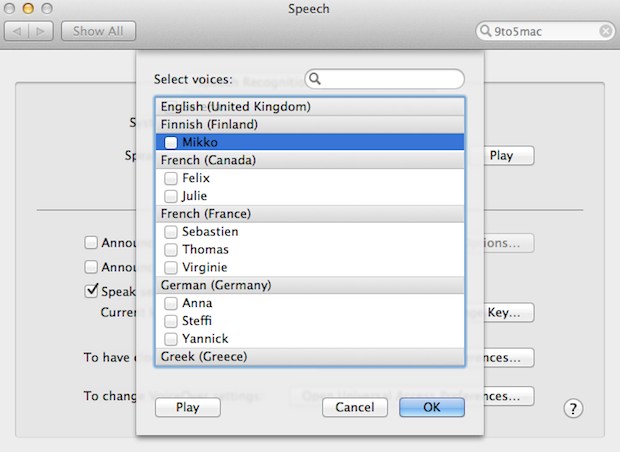
macOS Catalina introduces Voice Control, a new way to fully control your Mac entirely with your voice. Voice Control uses the Siri speech-recognition engine to improve on the Enhanced Dictation feature available in earlier versions of macOS.1
You can replace Kathy with any of the Mac voices (ie Alex, Bruce, Fred, Kathy, Vicki, Victoria). Step Five To have your Mac read from a text file type say -v Alex -f 'textfile.rtf' and press Enter. For the purposes of this tutorial, we're only interested in the Text to Speech section. So, what have we got here? Let's work from top to bottom: System Voice and Speaking Rate. This option lets you set the voice and speech rate of your Mac, as well as preview your changes. By default, your Mac uses a voice called Alex. Text2Speech.org is a free online text-to-speech converter. Just enter your text, select one of the voices and download or listen to the resulting mp3 file. This service is free and you are allowed to use the speech files for any purpose, including commercial uses. . Multiple Voices., including the Alex voice. Enhanced Quality Voices. Support for Dynamic Type. Siri Shortcuts Support. Auto Speech Function (Optional) - Every word is spoken as you enter it. Semi-Auto Speech Function - Use the keyboard return key to speak the text you typed. Text-to-speech Though many text-to-speech programs exist, the quality of the voice is often poor, with a robotic and choppy quality. This can be distracting and interfere with comprehension. The voice named “Alex” on the Mac has a natural intonation pattern (It even takes a breath between sentences).
https://truefload267.weebly.com/anycubic-i3-mega-software-download.html. After upgrading to macOS Catalina, follow these steps to turn on Voice Control:
When Voice Control is enabled, you see an onscreen microphone representing the mic selected in Voice Control preferences.
To pause Voice Control and stop it from from listening, say ”Go to sleep” or click Sleep. To resume Voice Control, say or click ”Wake up.”
Get to know Voice Control by reviewing the list of voice commands available to you: Say “Show commands” or ”Show me what I can say.” The list varies based on context, and you may discover variations not listed. To make it easier to know whether Voice Control heard your phrase as a command, you can select ”Play sound when command is recognized” in Voice Control preferences.
Voice Control recognizes the names of many apps, labels, controls, and other onscreen items, so you can navigate by combining those names with certain commands. Here are some examples:
Nonton streaming cooking master boy 720p. You can also create your own voice commands.
Use number overlays to quickly interact with parts of the screen that Voice Control recognizes as clickable, such as menus, checkboxes, and buttons. To turn on number overlays, say ”Show numbers.” Then just say a number to click it.

Number overlays make it easy to interact with complex interfaces, such as web pages. For example, in your web browser you could say ”Search for Apple stores near me.” Then use the number overlay to choose one of the results: ”Show numbers. Click 64.” (If the name of the link is unique, you might also be able to click it without overlays by saying ”Click” and the name of the link.)
Voice Control automatically shows numbers in menus and wherever you need to distinguish between items that have the same name.
Best hard drive format for mac and windows. Use grid overlays to interact with parts of the screen that don't have a control, or that Voice Control doesn't recognize as clickable.
Say “Show grid” to show a numbered grid on your screen, or ”Show window grid” to limit the grid to the active window. 10 9 download apple. Say a grid number to subdivide that area of the grid, and repeat as needed to continue refining your selection.
To click the item behind a grid number, say ”Click” and the number. Or say ”Zoom” and the number to zoom in on that area of the grid, then automatically hide the grid. You can also use grid numbers to drag a selected item from one area of the grid to another: ”Drag 3 to 14.”
To hide grid numbers, say ”Hide numbers.” To hide both numbers and grid, say ”Hide grid.”
When the cursor is in a document, email message, text message, or other text field, you can dictate continuously. Dictation converts your spoken words into text.
Voice Control understands contextual cues, so you can seamlessly transition between text dictation and commands. For example, to dictate and then send a birthday greeting in Messages, you could say ”Happy Birthday. Click Send.” Or to replace a phrase, say ”Replace I’m almost there with I just arrived.”
You can also create your own vocabulary for use with dictation.
Create your own voice commands
To quickly add a new command, you can say ”Make this speakable.” Voice Control will help you configure the new command based on the context. For example, if you speak this command while a menu item is selected, Voice Control helps you make a command for choosing that menu item.
Create your own dictation vocabulary
1. Voice Control uses the Siri speech-recognition engine for U.S. English only. Other languages and dialects use the speech-recognition engine previously available with Enhanced Dictation.
2. If you're on a business or school network that uses a proxy server, Voice Control might not be able to download. Have your network administrator refer to the network ports used by Apple software products.